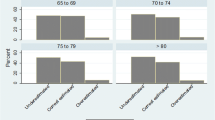Abstract
Background
A bias in perceived risk for health outcomes, including fracture, exists.
Purpose
We compared perceived risk and biases in perceived risk for fracture to fracture preventive behavior.
Methods
Women over age 55 (n = 2874) completed a survey five times over 5 years, and data was pulled from the medical record. Perceived risk was measured by asking women to rate their risk of fracture compared to similar women. Actual risk was measured using FRAX score. Bias was measured using an interaction between perceived and actual risk.
Results
Higher perceived risk was related to lower quality of life and self-reported health, more medication and calcium use, increased bone density scan use, and less walking. Bias was only associated with less medication use. Neither perceived risk nor bias predicted medication adherence.
Conclusions
Perceived risk, but not bias, may predict different fracture prevention behaviors. Clinicians may need to base interventions on risk perceptions.
Similar content being viewed by others
References
van Staa TP, Dennison EM, Leufkens HG, et al. Epidemiology of fractures in England and Wales. Bone. 2001; 29(6): 517-22.
Abrahamsen B, van Staa T, Ariely R, et al. Excess mortality following hip fracture: A systematic epidemiological review. Osteoporos Int. 2009; 20(10): 1633-50.
South-Paul JE. Osteoporosis: Part II. Nonpharmacologic and pharmacologic treatment. Am Fam Physician. 2001; 63(6): 1121-8.
Jackson RD, LaCroix AZ, Gass M, et al. Calcium plus vitamin D supplementation and the risk of fractures. N Engl J Med. 2006; 354(7): 669-83.
Brewer NT, Weinstein ND, Cuite CL, et al. Risk perceptions and their relation to risk behavior. Ann Behav Med. 2004; 27(2): 125-30.
Katapodi MC, Lee KA, Facione NC, et al. Predictors of perceived breast cancer risk and the relation between perceived risk and breast cancer screening: a meta-analytic review. Prev Med. 2004; 38(4): 388-402.
Reventlow SD. Perceived risk of osteoporosis: restricted physical activities? Qualitative interview study with women in their sixties. Scand J Prim Health Care. 2007; 25(3): 160-5.
Weinstein ND. Unrealistic optimism about future life events. J Pers Soc Psychol. 1980; 39: 806-20.
Klein WMP. Optimistic Bias. Washington: National Cancer Institute; 2008 [cited 2014 3/7/2014].
Cho H, Lee JS, Lee S. Optimistic bias about H1N1 Flu: Testing the links between risk communication, optimistic bias and self-protection behavior. Health Commun. 2014; 28(2): 146-58.
Sharot T. The optimism bias. Curr Biol. 2011; 21(23): R941-5.
Harris PR, Griffin DW, Murray S. Testing the limits of optimistic bias: Event and person moderators in a multilevel framework. J Pers Soc Psychol. 2008; 95(5): 1225-37.
Charles ST. Strength and vulnerability integration: A model of emotional well-being across adulthood. Psychol Bull. 2010; 136(6): 1068-91.
Hooven FH, Adachi JD, Adami S, et al. The Global Longitudinal Study of Osteoporosis in Women (GLOW): Rationale and study design. Osteoporos Int. 2009; 20(7): 1107-16.
Siris ES, Gehlbach S, Adachi JD, et al. Failure to perceive increased risk of fracture in women 55 years and older: The Global Longitudinal Study of Osteoporosis in Women (GLOW). Osteoporos Int. 2011; 22(1): 27-35.
Gregson CL, Dennison EM, Compston JE, et al. Disease-specific perception of fracture risk and incident fracture rates: GLOW cohort study. Osteoporos Int. 2014; 25(1): 85-95.
Kanis JA, Johnell O, Oden A, et al. FRAX and the assessment of fracture probability in men and women from the UK. Osteoporos Int. 2008; 19(4): 385-97.
Oemar M, Janssen B. EQ-5D-5L User Guide: Basic information on how to use the EQ-5D-5L instrument. 2013.
Services DoHaH. 2008 physical activity guidelines for Americans. Washington, DC: Department of Health and Human Services, 2008.
Garg RK, Glazer NL, Wiggins KL, et al. Ascertainment of warfarin and aspirin use by medical record review compared with automated pharmacy data. Pharmacoepidemiol Drug Saf. 2011; 20(3): 313-6.
Glymour MM, Weuve J, Berkman LF, et al. When is baseline adjustment useful in analyses of change? An example with education and cognitive change. Am J Epidemiol. 2005; 162(3): 267-78.
Weinstein ND. Misleading tests of health behavior theories. Ann Behav Med. 2007; 33(1): 1-10.
Thissen D, Steinberg L, Kuang D. Quick and easy implementation of the Benjamini-Hochberg procedure for controlling the false positive rate in multiple comparisons. J Educ Behav Stat. 2002; 27(1): 77-83.
Black DM, Cummings SR, Karpf DB, et al. Randomised trial of effect of alendronate on risk of fracture in women with existing vertebral fractures. Fract Interv Trial Res Group Lancet. 1996; 348(9041): 1535-41.
Acknowledgments
The authors would like to thank the study participants and all the research staff who worked on this project. Drs. Jones, Gell, and Roth are supported by fellowships from the National Institute on Aging (T32 AG027677). Funding for this study was provided by The Alliance for Better Bone Health (Procter & Gamble Pharmaceuticals and Sanofi-Aventis) to The Center for Outcomes Research, University of Massachusetts Medical School.
Authors’ Statement of Conflict of Interest and Adherence to Ethical Standards
Drs. Scholes, Jones, Gell, and Roth do not have any conflict of interest to report. Dr. LaCroix serves on the advisory council of the GLOW study and has been supported by Sanofi-Aventis. All procedures, including the informed consent process, were conducted in accordance with the ethical standards of the responsible committee on human experimentation (institutional and national) and with the Helsinki Declaration of 1975, as revised in 2000.
Author information
Authors and Affiliations
Corresponding author
Electronic supplementary material
Below is the link to the electronic supplementary material.
ESM 1
(DOC 37 kb)
About this article
Cite this article
Jones, S.M.W., Gell, N.M., Roth, J.A. et al. The Relationship of Perceived Risk and Biases in Perceived Risk to Fracture Prevention Behavior in Older Women. ann. behav. med. 49, 696–703 (2015). https://doi.org/10.1007/s12160-015-9702-7
Published:
Issue Date:
DOI: https://doi.org/10.1007/s12160-015-9702-7



